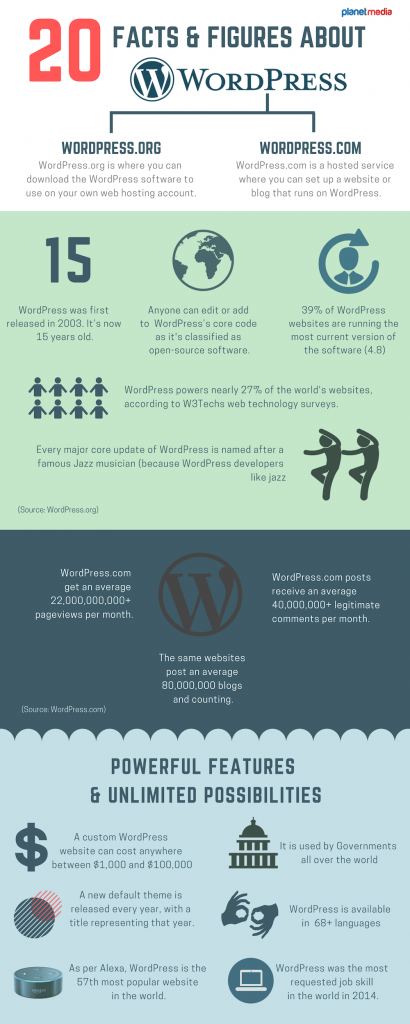14 Facts & Figures About WordPress

The internet accommodates over 1.8 billion websites as of today and the amount of active users is no less than 200 million. Of this, more than one-quarter of them uses WordPress.
Since the inception of its first version, 0.7, in 2003 to the current 5.0.1 version, much has changed, including advanced plugins, much-refined UI, streamlined dashboards, widgets, themes and many other features.
“With almost 32.5% of all the websites powered by WordPress is now the most popular content management platform; a dominant force online."
(Source: W3Techs)
While most of us in the digital world are familiar with WordPress, it is important not to confuse WordPress (software) with WordPress.com (the hosted solution).
It all started when Matt Mullenweg, and Mark Little, who joined later, decided to take the blogging software to next level. They released the first version of WordPress in 2003, making it older than Facebook or Twitter.
If someone tells you that WordPress is a ‘community’ software, don’t be surprised. It simply means that individuals around the globe have contributed to it by submitting codes, fixing bugs, testing, translating and teaching others how to use it.
54,625+ WordPress Plugins and counting
For WordPress, plugins are like how apps are to your smartphone. With WordPress plugins, you can add features and extend functionalities for your website without actually spending the cost of custom development. There are more than 54,625+ plugins available on WordPress.org, which means limitless possibilities.
WordPress Themes
WordPress themes control the look and feel of your site. You can either pay for the theme or use the free themes in the theme directory. The first default WordPress theme was called Kubrick and it was developed in 2005.
The following infographic contains some of the key facts and figures about WordPress.

WordPress is Growing Ahead of its Competitors
In a study made by W3Techs, in the year 2017-18, WordPress has grown by 4%. Meanwhile, their competitors, Joomla and Drupal’s market share diminished from 3.4% to 3.1% and from 2.2% to 2.1% respectively. In the following graph by Google Trends, you can notice how big is WordPress compared to its competitors.
(Source: Google Trends)
From individual freelancers and bloggers to big corporates, WordPress gives people the perfect platform to share their passion, promote their brands and engage with a wider audience thus putting forward for the world to notice what an ideal CMS platform should be like.
If you want your business or organisation to benefit from the wide range of opportunities Wordpress offers? Our team of expert designers and developers are here to help. Drop us a line at hello@planetmedia.com.au and let us know what you want to achieve.



